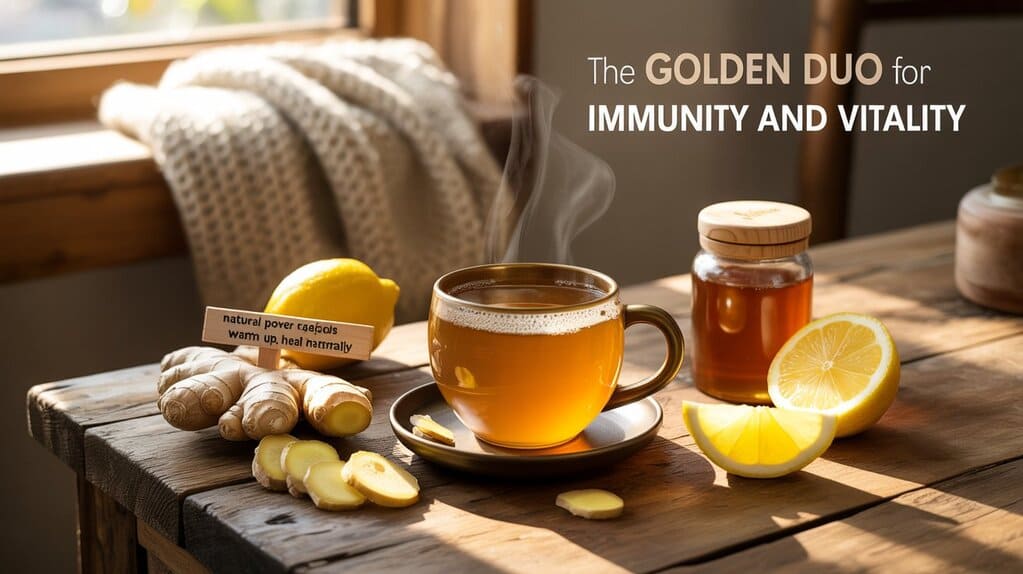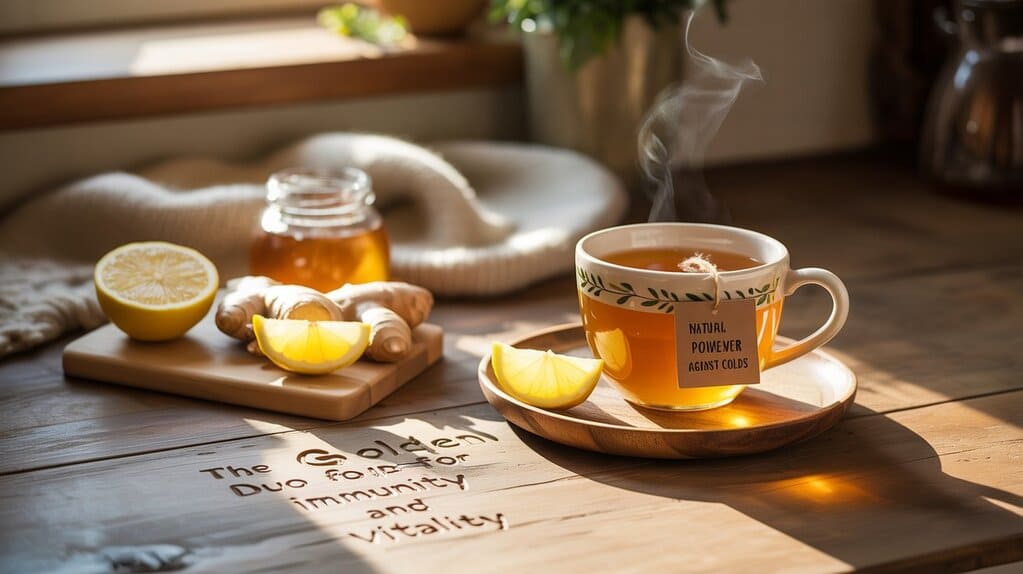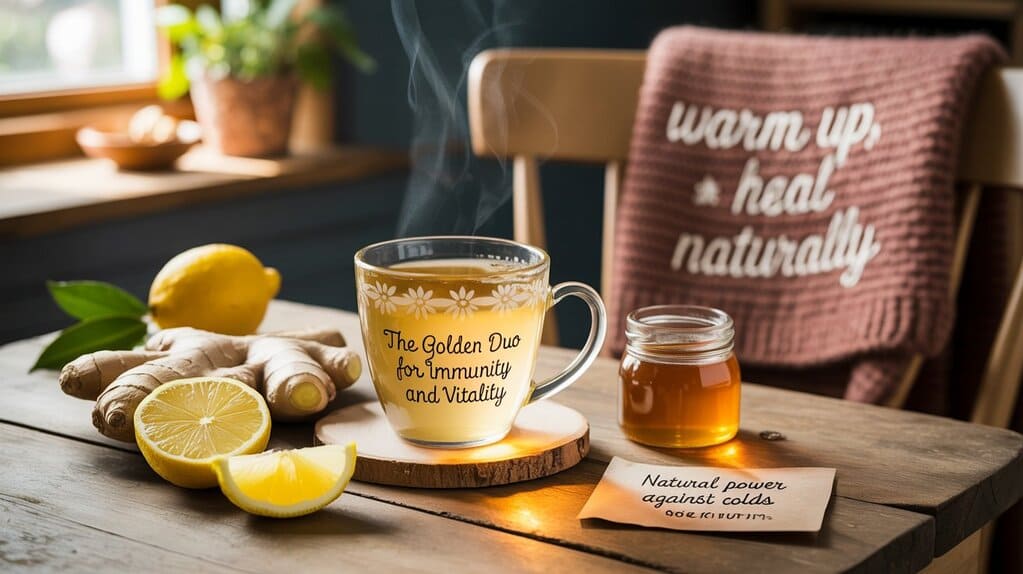
Introduction
Ginger (Zingiber officinale) and lemon (Citrus limon) form a time-honored natural pairing used across cultures to ease respiratory symptoms, reduce cold duration, and support the immune system. Modern research has investigated ginger’s anti-inflammatory and antiviral compounds (like 6-gingerol and 6-shogaol) and lemon’s high vitamin C and antioxidant content. Together, ginger and lemon create a synergistic beverage and topical remedies that are easy to prepare, widely available, and generally safe for most adults when used appropriately. This article summarizes the biochemical actions, clinical evidence, practical preparations, safety notes, and up-to-date scientific literature so you can use this duo intelligently for cold symptom relief and immune support. PMC+1
Why ginger and lemon? Short scientific rationale
- Ginger contains bioactive phenolics — chiefly 6-gingerol and 6-shogaol — that have demonstrated anti-inflammatory, antioxidant, and antiviral activity in laboratory and animal studies. These compounds can modulate inflammatory mediators (for example, lowering IL-6 and TNF-α) and may reduce mucosal inflammation in upper respiratory infections. PMC+1
- Lemon supplies ascorbic acid (vitamin C), flavonoids, and other antioxidants that help neutralize free radicals, support immune cell function, and — according to randomized trials and meta-analyses — can modestly shorten the duration and reduce severity of colds when used regularly or at sufficient doses. Vitamin C’s role is best understood as supportive rather than curative. PubMed+1
- When combined — for example as a warm infusion of fresh ginger slices with lemon juice and honey — the beverage delivers anti-inflammatory compounds, vitamin C, and soothing effects on sore throats and cough. Clinical trials and reviews suggest the combination is plausible for symptomatic relief and may support recovery, though the strength of evidence varies by condition and study design. PMC+1

Evidence from recent scientific and medical studies (Asia, Europe, North America)
- Systematic reviews and narrative reviews (Europe/International): Reviews of ginger’s pharmacology highlight anti-inflammatory and immunomodulatory activities of gingerols and shogaols; authors in Europe and elsewhere summarize in vitro and in vivo evidence that supports ginger’s potential to modulate immune responses. PMC+1
- Clinical trials (Asia / Middle East): Randomized trials have tested ginger (sometimes combined with other herbs) for symptom relief in viral respiratory illnesses. Some trials reported faster symptom improvement or reduced hospitalization risk when ginger was part of a multi-herb intervention, though many studies had small sample sizes and heterogeneous designs. De Gruyter Brill+1
- Vitamin C (Europe / North America reviews): Large meta-analyses and Cochrane reviews show that regular vitamin C supplementation modestly shortens the duration of colds and reduces symptom severity, especially in people under physical stress or with severe colds. Therapeutic use after symptom onset shows more mixed results, but overall, vitamin C is one of the most consistently supported nutritional interventions for common cold symptom reduction. PubMed+1
- Mechanistic and laboratory studies (Asia, Europe, North America): Research into 6-gingerol and related compounds indicates suppression of pro-inflammatory signaling and antioxidant protection—mechanisms that plausibly reduce mucosal inflammation and symptom severity during viral infections. ScienceDirect+1
Bottom line: evidence supports ginger’s anti-inflammatory and potential antiviral properties (laboratory + some clinical data) and vitamin C’s modest clinical benefits for shortening and reducing the severity of colds (meta-analyses). Combining both is biologically plausible and commonly recommended as a symptomatic, supportive approach rather than a standalone cure. PMC+1
Key nutrients and compounds — quick reference table
| Item | Main active constituents | Common benefits relevant to colds & immunity |
|---|---|---|
| Ginger (fresh) | 6-gingerol, 6-shogaol, zingerone | Anti-inflammatory, antioxidant, possible antiviral effects, soothes sore throat. PMC |
| Lemon (fresh juice) | Vitamin C (ascorbic acid), flavonoids (hesperidin, eriocitrin), citric acid | Antioxidant, supports leukocyte function, may reduce cold severity and duration when supplemented. PubMed |
| Honey (optional) | Flavonoids, phenolic acids | Soothes throat, mild antimicrobial properties; useful in children >1 year and adults. (Not for infants.) |
(Values vary by fruit/ginger size and preparation.)

Practical preparations and usage
Here are simple, safe, evidence-informed ways to use ginger and lemon for colds and mild immune support:
- Basic ginger-lemon infusion (hot):
- Slice 1–2-inch piece of fresh ginger thinly.
- Boil in 300–400 mL water for 5–10 minutes.
- Remove from heat, add the juice of ½–1 lemon and 1 tsp honey (optional).
- Sip warm, 2–3 times daily for symptom relief and hydration.
- Cold-brewed ginger-lemon tea (soothing, less pungent):
- Place sliced ginger in cold water overnight in the fridge, strain next morning, add lemon juice and honey as desired.
- Ginger-lemon with turmeric booster: add a pinch of ground turmeric to the brew for additional anti-inflammatory compounds (bioavailability improved with black pepper).
Dosage and frequency: these are culinary/therapeutic doses used in trials and traditional practice. There is no universal standardized dose; most studies use extracts or standardized preparations. For everyday supportive use, 1–3 cups per day of a ginger-lemon infusion is common. Consult a clinician before taking high-dose ginger supplements or vitamin C megadoses. PMC+1

Safety, contraindications, and drug interactions
- Pregnancy and breastfeeding: Fresh ginger in culinary amounts is generally regarded as safe; however, pregnant women should consult their healthcare provider before high-dose ginger supplements.
- Blood-thinning medications: Ginger has mild antiplatelet effects; those on anticoagulants (e.g., warfarin) should check with their doctor before chronic high-dose ginger use.
- Infants: Avoid honey in infants under 12 months.
- High-dose vitamin C: Large daily doses may cause gastrointestinal upset or increase kidney stone risk in susceptible individuals. Always consult a clinician for chronic high-dose supplementation. PMC+1
Key points (SEO-friendly, bolded)
- Ginger is rich in anti-inflammatory compounds (6-gingerol, 6-shogaol) that help modulate immune responses and may reduce respiratory inflammation. PMC
- Lemon provides vitamin C and flavonoids, antioxidants that support immune cell function and can modestly shorten cold duration when used regularly. PubMed
- The ginger-lemon infusion is a low-cost, accessible home remedy for sore throat, cough, and hydration that complements standard medical care.
- Current evidence supports the symptomatic and supportive use of ginger and vitamin C — not as a replacement for professional medical treatment of severe respiratory infections. PubMed+1
Short figure (conceptual) — How the duo helps (textual flow)
- Ingestion → 2. Bioactive delivery (gingerols, vitamin C) → 3. Antioxidant & anti-inflammatory effects → 4. Reduced mucosal inflammation and symptom severity → 5. Faster subjective recovery / improved comfort
Conclusion
Ginger and lemon are a practical, culturally universal combination that offers anti-inflammatory, antiviral (preclinical), and antioxidant benefits. Clinical evidence — particularly meta-analyses on vitamin C and trials of ginger-containing preparations — supports the symptomatic use of this duo to reduce cold severity and, in some settings, duration. While more high-quality randomized controlled trials of standardized ginger preparations in uncomplicated colds are desirable, current research justifies using ginger and lemon as a low-risk, supportive option for mild respiratory symptoms, throat comfort, and immune-focused nutrition. Always consult a healthcare professional for severe or persistent symptoms, and be mindful of contraindications, especially when taking medications or treating infants and pregnant individuals. PMC+2PubMed+2
References
- Ballester P, et al. Effect of Ginger on Inflammatory Diseases. (Review). PMC. 2022. (Review of anti-inflammatory actions of ginger, including 6-gingerol). PMC
- Hemilä H. Vitamin C for preventing and treating the common cold. Cochrane Review / PubMed summary. 2013; later meta-analyses 2023 update show vitamin C reduces cold severity/duration in some settings. PubMed+1
- Promdam N., et al. [6]-Gingerol: A narrative review of its beneficial effect. 2022. (Discusses biochemical mechanisms of 6-gingerol — anti-inflammatory, antiviral potential). ScienceDirect
- Mesri M., et al. The effects of combination of Zingiber officinale and Echinacea on alleviation of clinical symptoms… Journal of Complementary and Integrative Medicine. 2021. (Randomized clinical trial, Iran). De Gruyter Brill
- Hemilä H. Vitamin C reduces the severity of common colds: a meta-analysis. BMC Public Health. 2023. (Meta-analysis finding modest reduction in severity/duration). PubMed
- Yücel Ç., et al. Immunomodulatory and anti-inflammatory therapeutic actions of ginger compounds. Frontiers / Pharmacology. 2022. (Mechanistic insights and pharmacology). Frontiers
- Wardani RS., et al. Treatment of the common cold with herbs used in Ayurveda and traditional systems. (Review). 2023. (Context for traditional use of ginger). PMC





